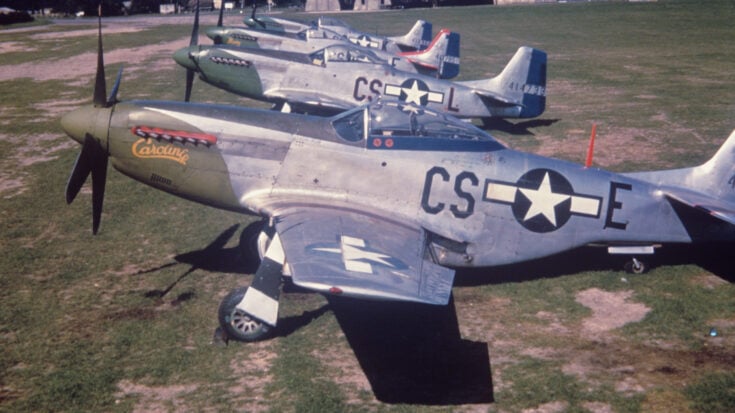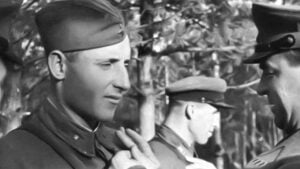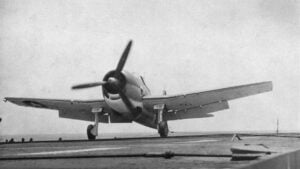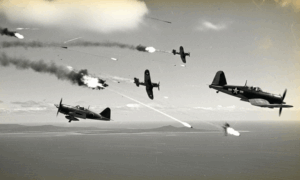The Clever Trick That Let a Squadron Destroy 40 Enemy Fighters in Just One Month

Photo by See page for author, Public domain, via Wikimedia Commons
A Sky Full of Death
In March 1944, Captain James “Red” Holt flew his P-47 Thunderbolt above Brunswick, Germany, guarding hundreds of bombers heading toward enemy targets. Each Flying Fortress carried ten men and tons of explosives. Below the clouds, German fighters waited for one thing—wounded bombers. They had learned that crippled planes lagged behind, easier to destroy.
The numbers told the story. Since January, the Eighth Air Force had lost nearly 300 heavy bombers, thousands of men gone. Escorts like Holt’s 359th Fighter Squadron couldn’t cover every straggler. German pilots ignored strong formations and instead circled until they spotted a bomber trailing smoke. Then they struck, killing the crew before help could arrive. American losses mounted each week, and morale began to sink.

A Problem Without a Solution
Commanders tried everything. They sent fighters to escort damaged bombers home, but the Germans waited until the escorts ran low on fuel. They adjusted patrol routes, added radio calls, even improved armor. Nothing worked. As one officer admitted, the enemy had “turned our wounded into bait.” The idea of abandoning crippled bombers was even discussed—until General Dwight D. Eisenhower scrawled one word across the proposal: Never.
But idealism did not stop the dying. Crews began fearing damage more than death. Being shot down was quick; limping home meant half an hour of torture under constant attack. By mid-March, pilots were breaking down under pressure. Something had to change—and fast.
The Artist’s Napkin
The answer came from an unlikely man: Technical Sergeant Daniel Weiss, a 24-year-old Brooklyn artist turned crew chief. Weiss had worked for an advertising agency before the war, designing illusions that made ordinary products look appealing. He had failed the vision test to become a pilot, but his eye for detail and realism made him invaluable in maintaining aircraft.
One evening, sitting in the officer’s club, Weiss doodled a Thunderbolt covered in fake bullet holes and smoke. As he looked at his sketch, an idea formed—what if they pretended to be wounded? If the Germans attacked only damaged aircraft, why not make a few look like perfect bait? Weiss showed the drawing to Captain Holt, explaining how painted bullet holes and theatrical smoke could lure the enemy into a trap. Holt thought it was crazy—but he listened.

The Bait Is Built
With reluctant approval from Lieutenant Colonel Joseph Dickman, Weiss and a small crew turned three P-47s into flying decoys. They used painted bullet holes and detachable “damaged” panels molded from acetate sheets. Smoke generators were hidden under the fuselage to mimic oil leaks. Pilots learned to fly like wounded birds—slowing down, losing altitude slightly, and acting unsteady—all while keeping full combat strength.
When they tested the idea, even seasoned mechanics were fooled from a distance. The planes looked broken, yet flew perfectly. The plan was simple: draw in the hunters, then strike from above with hidden escort fighters.
The First Trap
On March 22, 1944, the 359th Squadron put the idea to the test. Holt led the decoy flight, trailing behind the bomber formation with smoke pouring from his Thunderbolt. German radar quickly picked him up. Six fighters pounced, expecting an easy kill. As they dove in, Holt’s “damaged” plane roared to full power, and eight American fighters hidden above swooped down. In less than two minutes, four German aircraft were destroyed, the rest scattered. Not a single American plane was hit.
The results stunned everyone. Within days, other squadrons copied the tactic. Each mission brought more victories. Between late March and mid-April, the 359th Squadron alone shot down 40 German fighters while losing none. Bomber losses were cut nearly in half. Captured pilots admitted they no longer trusted what they saw—“What looks weak may be strong,” one said. The once-deadly German “wolfpack” tactics collapsed within weeks.

The Legacy of Deception
Soon, entire fighter groups trained in Weiss’s methods. Mechanics became experts in painting fake damage between missions. The deception saved an estimated 180 bomber crews in a single month. Commanders called it the most effective psychological tactic of the air war. Weiss, once a frustrated artist, quietly received the Legion of Merit for “advanced camouflage development.”
After the war, he returned to advertising and rarely spoke of his creation. When a historian found him in 1989, Weiss simply said, “I just solved a visual problem. They were looking for wounded planes—we showed them wounded planes.”
His clever trick didn’t just save aircraft. It saved lives, and perhaps more importantly, it changed how warfare itself was seen—not as brute strength, but as the art of making the enemy see what you want them to see.



















